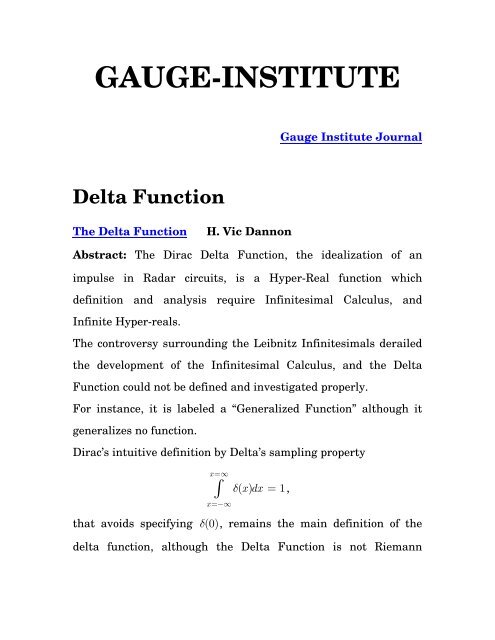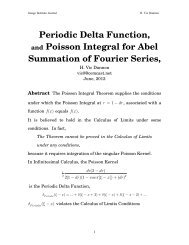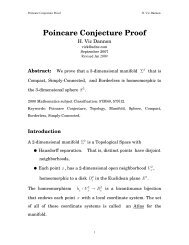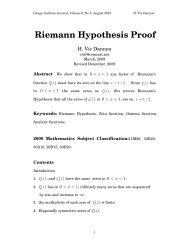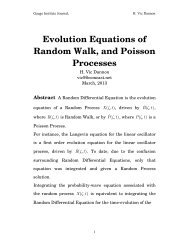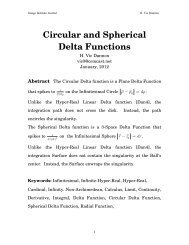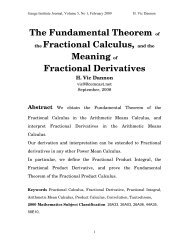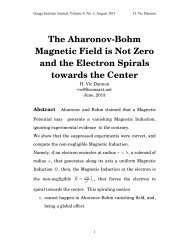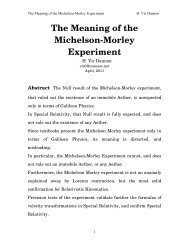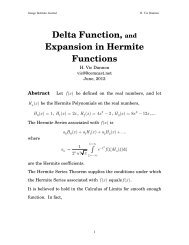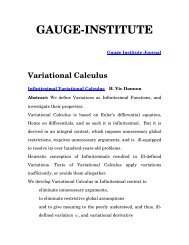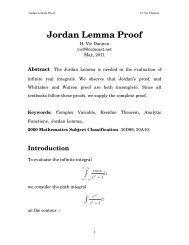Delta Function - Gauge-institute.org
Delta Function - Gauge-institute.org
Delta Function - Gauge-institute.org
You also want an ePaper? Increase the reach of your titles
YUMPU automatically turns print PDFs into web optimized ePapers that Google loves.
GAUGE-INSTITUTE<strong>Gauge</strong> Institute Journal<strong>Delta</strong> <strong>Function</strong>The <strong>Delta</strong> <strong>Function</strong>H. Vic DannonAbstract: The Dirac <strong>Delta</strong> <strong>Function</strong>, the idealization of animpulse in Radar circuits, is a Hyper-Real function whichdefinition and analysis require Infinitesimal Calculus, andInfinite Hyper-reals.The controversy surrounding the Leibnitz Infinitesimals derailedthe development of the Infinitesimal Calculus, and the <strong>Delta</strong><strong>Function</strong> could not be defined and investigated properly.For instance, it is labeled a “Generalized <strong>Function</strong>” although itgeneralizes no function.Dirac’s intuitive definition by <strong>Delta</strong>’s sampling propertyx =∞∫ δ( xdx ) = 1,x =−∞that avoids specifyingδ(0) , remains the main definition of thedelta function, although the <strong>Delta</strong> <strong>Function</strong> is not Riemann
integrable in the Calculus of Limits, and is not Lebesgueintegrable in Measure Theory.In fact, in the Calculus of Limits, only the Cauchy Principal ValueIntegral of the <strong>Delta</strong> <strong>Function</strong> exists, and it equals zero.Only in Infinitesimal Calculus, can the <strong>Delta</strong> <strong>Function</strong> be defined,differentiated, and integrated.Infinitesimal Calculus allows us to resolve open problems such asWhat is δ(0) ?How is xδ( x)defined at x = 0 ?How is the <strong>Delta</strong> <strong>Function</strong> the derivative of a Step <strong>Function</strong>?How do we integrate the <strong>Delta</strong> <strong>Function</strong>?What is δ (x )?What is δ2 ( x)?What is δ(x )?What is δ3 ( x)?23The <strong>Delta</strong> <strong>Function</strong> enables us to define the Fourier Transformwith minimal requirements on the transformed function.<strong>Delta</strong> <strong>Function</strong>, the Fourier Transform, and FourierIntegral TheoremH. Vic DannonAbstract: The Fourier Integral Theorem guarantees that theFourier Transform and its Inverse are well defined operations, sothat the inversed transform is the originally transformed function.
It is believed to hold in the Calculus of Limits under some highlyrestrictive sufficient conditions. In fact,The Theorem does not hold in the Calculus of Limitsunder any conditions,because evaluating the Fourier Integral requires the integration ofthat diverges at x = ξ .k =∞ik( x−ξ)∫ e dk,k =−∞Only in Infinitesimal Calculus, the integral is the Hyper-real<strong>Delta</strong> <strong>Function</strong>k =∞1 ik( x−ξ)δ( x − ξ)= e2π∫ dk,k =−∞and the Fourier Integral Theorem states the sifting property forthe <strong>Delta</strong> <strong>Function</strong>ξ=∞f ( x) = ∫ f( ξδξ ) ( −x)d ξ.ξ=−∞In infinitesimal Calculus we can integrate over singularities, andthe Fourier Integral Theorem holdsk =∞ ⎛ ξ=∞⎞1−ikξf ( x) = f( ξ)e ξ2πk =−∞ ⎜⎝ξ=−∞⎠⎟where the Integrals are Hyper-real.ikx∫ ∫ d e dk,
The highly restrictive conditions for the Fourier Integral Theorem,in the Calculus of Limits, are irrelevant to the simplest functions,such as constants, and useless for singular functions.In particular, the singularδ( x)violates these conditions the Hyper-real <strong>Delta</strong>δ( x)is not defined in the Calculus ofLimits, and is not Piecewise Continuous.δ'( x)is not defined, and is not Piecewise Continuous in anybounded interval.But in Infinitesimal Calculus,Fourier integral Theoremδ( x)satisfies the Hyper-realk =∞ ⎛ ξ=∞⎞1−ikξikxδ( x) = δ( ξ)e2π∫ ∫ dξ e dk.k =−∞ ⎜⎝ξ=−∞ ⎠⎟Also, the constant function f ( x) ≡ 1 violates the sufficientx =∞conditions’ requirement of absolute integrability, ∫ 1 dx =∞.x =−∞But in Infinitesimal Calculus, f ( x) ≡ 1 satisfies the Hyper-realFourier integral Theorem1k =∞ ⎛ ξ=∞⎞1−ikξikx= e dξe d2πk =−∞ ⎜⎝ξ=−∞⎠⎟∫ ∫ k.


